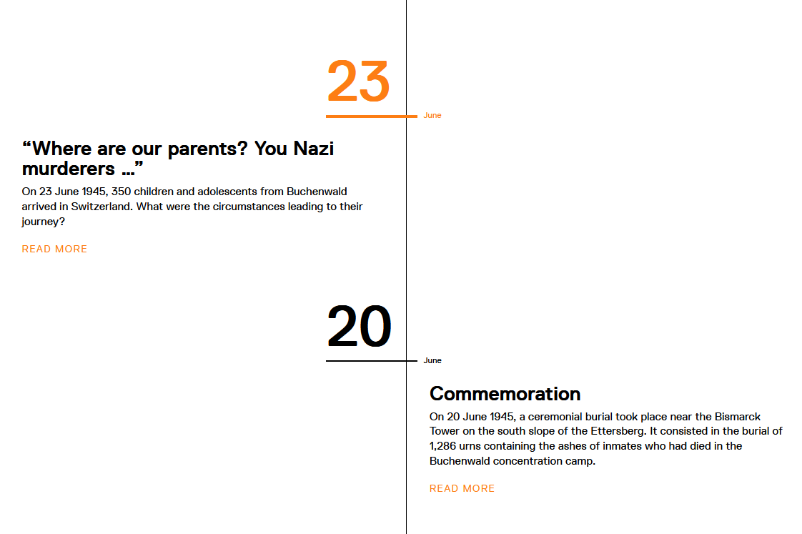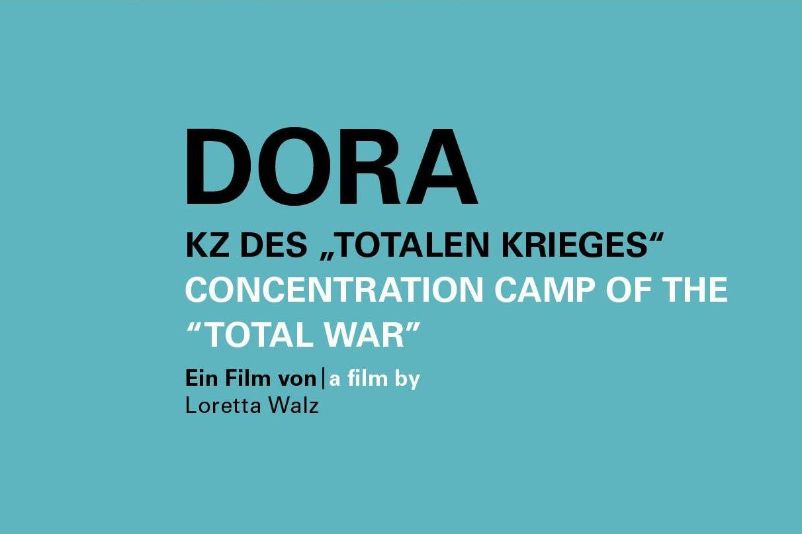Nordhausen under national socialism - a guide

The historical guide reports on the few town citizens who opposed the National Socialists and retraces the fates of those residents of Nordhausen who were subjected to persecution, excluded from the Nazi “people’s community”, and in many cases murdered. After the war began, forced labourers were part of the everyday townscape. Nearly all of Nordhausen’s businesses profited from the forced labour of foreign men, women and children.
Blog #otd1945

The Final Months of the Buchenwald and Mittelbau-Dora Concentration Camps
The blog #otd1945 (“on this day 1945”) takes a day-by-day look at what was going on in the Buchenwald and Mittelbau-Dora concentration camps in the months between January and June 1945.
In early 1945, many concentration camp inmates hoped liberation was near. They knew it was merely a matter of time before Germany lost the war. But the killing in the camps and at the sites of forced labour did not let up. On the contrary, it escalated.
The situation of the German public and the concentration camp inmates respectively could hardly have been more different. Whereas the former carried on, joined in, or simply looked the other way, the latter struggled for sheer survival under the disastrous conditions in the overcrowded camps.
The mass deaths did not end with the liberation of the Buchenwald and Mittelbau-Dora camps on 11 April. Many of the inmates who had been forced to set out on death marches remained in captivity until the German surrender on 8 May. And even afterwards, inmates continued to die of the consequences of concentration camp imprisonment.
Exhibition: „The First Transport“

(Arolsen Archives)
The Foundation of the Mittelbau-Dora Concentration Camp
From 17 August, the articles of the poster exhibition "The First Transport", which commemorates the arrival of the first prisoners at the Mittelbau-Dora concentration camp 80 years ago, will appear here.
In the early morning hours of 28 August 1943, the SS herded 107 inmates to the gates of the Buchenwald Concentration Camp. They had been selected for the "Transport Süd" (southern transport), which in reality headed north. They were taken by truck to the Kohnstein, a 335 meter-high hill in the Harz foothills near Nordhausen, where they were forced to perform heavy labor, converting an underground fuel depot into a bomb-proof armaments factory.
The arrival of these first 107 inmates marked the establishment of the "Dora Labor Camp". In the following 15 months, it was expanded into the sprawling concentration camp complex Mittelbau, with a total of 60,000 inmates.
Exhibition: After the liberation

Footage: George Stevens / US Army Signal Corps (Library of Congress, Washington)
Mittelbau-Dora in the spring 1945
From April 2025, the content of the outdoor exhibition “After the liberation. Mittelbau-Dora in the spring 1945” will be presented here. It focuses on the camps and the surrounding area in the weeks following liberation.
When US troops liberated the Mittelbau-Dora concentration camp on April 11, 1945, only a few survivors were left in the camps. The vast majority of the prisoners had recently been forced onto clearance transports and death marches. Along the routes of these transports, thousands of prisoners died from exhaustion or at the hands of guards and civilians shortly before the end of the war.
The perspectives of the liberated, the liberators, and the local population in Nordhausen and Ellrich during this time are presented here.
Dora – Concentration Camp of the “Total War”

The film "Dora – Concentration Camp of the 'Total War'" tells the story of the penultimate concentration camp to be founded during the “Third Reich”. The inmates of the Mittelbau concentration camp were forced to work in the assembly of the “vengeance weapons” V1 and V2 propagated by the Nazi regime and in the construction of underground aircraft factories and fuel plants. Of the more than 60,000 Mittelbau inmates, one third did not survive concentration camp imprisonment.
Historical film footage and interviews with survivors provide an overview of what it meant to be an inmate of the Mittelbau concentration camp.
The passages shown here are from the documentary realized by the director Loretta Walz on behalf of the Mittelbau-Dora Concentration Camp Memorial.
Scholarly Articles about the history of Mittelbau-Dora Concentration Camp
Regine Heubaum: When the war came to Nordhausen - local engagement with challenges of memory politics
Only available for download in German! In many German cities, the NPD and other far-right groups regularly organise commemorative events on the occasion of the anniversaries of Allied air raids. These events are often held under the motto "Honourable commemoration instead of adaptation to the zeitgeist" and pander to narratives of victimhood that remain widespread among the bourgeois political middle to this day. The arguably best-known example for this is Dresden, which has repeatedly been at the centre of media attention in the last few years for how it handles commemorating the city's bombardment (cf. Fache 2009, Winter 2015)...

Jens-Christian Wagner: Bitter Taste of the Liberation
When the Red Army approached Auschwitz, the majority of the prisoners already had been evacuated, i.e. transferred to other camps. For many of them, Mittelbau-Dora near Nordhausen became a second hell.
January 27 is a peculiar date. In 1996 Roman Herzog, then president of the Federal Republic, proclaimed it a countrywide day of remembrance for the victims of National Socialism. It was the day when, in 1945, the Red Army had liberated the concentration and extermination camp of Auschwitz, southeast of Katowice.
...

©Private Collection
Regine Heubaum: The clearance of the Mittelbau-Dora concentration camp
Only available for download in German! The starting point for hte clearance of the Mittelbau camps were two air raids by the Royal Air Force on the town of Nordhausen on 3/4 April 1945, during which large parts of the town were destroyed and many people killed. From the subcamp Ellrich, which was only twelve kilometres distant from Nordhausen, the attack by the British bomber units was visibe. At the same time, the American ground forces were drawing nearer from the West and for days already the inmates had heard the artillery noise of the nearby front lines....

Jens-Christian Wagner: Remembering the Nazi camps in East and West Germany: The case of the Mittelbau-Dora camp
"'We didn’t know anything about what was going on in the Kohnstein and Camp Dora!’ That’s what they all say – the people now being held responsible for the consequences of the Nazi regime. But anyone who says something like that is lying! Every morning and every evening, everyone heard the zebra gangs marching through the City of Nordhausen. And everyone is sure to have turned and watched them pass at least once, and will have seen the men slinking along with their pale faces, accompanied by heavily armed SS. How often did a motor vehicle pass through the lower part of town headed for Weimar, stuffed with dead bodies being taken to the crematorium in Buchenwald. [...]"

Karsten Uhl: Cover stories. "From hell to the stars." The Mittelbau-Dora concentration camp in post-war narratives
Only available for download in German! The Mittelbau-Dora concentration camp is considered paradigmatic for concentration camp forced labour by historical research. For the purpose of moving the armaments industry - among other things the production of the "V2" rocket - underground, 60,000 people from occupied Europe were abducted to the southern Harz region. This essay examines the post-war cover stories circulating in the arts and entertainment industry, in which mention of Mittelbau-Dora was limited to the rocket myth and which with this thematization made the silence about the concentration camp possible in the first place.

